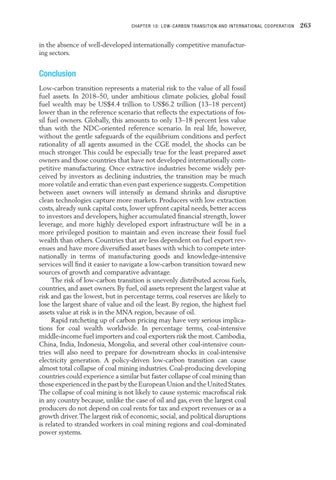CH AP TER 10: LO W-C AR B ON TR ANSITION AND INTER NATIONAL C OOPER ATION
in the absence of well-developed internationally competitive manufacturing sectors.
Conclusion Low-carbon transition represents a material risk to the value of all fossil fuel assets. In 2018–50, under ambitious climate policies, global fossil fuel wealth may be US$4.4 trillion to US$6.2 trillion (13–18 percent) lower than in the reference scenario that reflects the expectations of fossil fuel owners. Globally, this amounts to only 13–18 percent less value than with the NDC-oriented reference scenario. In real life, however, without the gentle safeguards of the equilibrium conditions and perfect rationality of all agents assumed in the CGE model, the shocks can be much stronger. This could be especially true for the least prepared asset owners and those countries that have not developed internationally competitive manufacturing. Once extractive industries become widely perceived by investors as declining industries, the transition may be much more volatile and erratic than even past experience suggests. Competition between asset owners will intensify as demand shrinks and disruptive clean technologies capture more markets. Producers with low extraction costs, already sunk capital costs, lower upfront capital needs, better access to investors and developers, higher accumulated financial strength, lower leverage, and more highly developed export infrastructure will be in a more privileged position to maintain and even increase their fossil fuel wealth than others. Countries that are less dependent on fuel export revenues and have more diversified asset bases with which to compete internationally in terms of manufacturing goods and knowledge-intensive services will find it easier to navigate a low-carbon transition toward new sources of growth and comparative advantage. The risk of low-carbon transition is unevenly distributed across fuels, countries, and asset owners. By fuel, oil assets represent the largest value at risk and gas the lowest, but in percentage terms, coal reserves are likely to lose the largest share of value and oil the least. By region, the highest fuel assets value at risk is in the MNA region, because of oil. Rapid ratcheting up of carbon pricing may have very serious implications for coal wealth worldwide. In percentage terms, coal-intensive middle-income fuel importers and coal exporters risk the most. Cambodia, China, India, Indonesia, Mongolia, and several other coal-intensive countries will also need to prepare for downstream shocks in coal-intensive electricity generation. A policy-driven low-carbon transition can cause almost total collapse of coal mining industries. Coal-producing developing countries could experience a similar but faster collapse of coal mining than those experienced in the past by the European Union and the United States. The collapse of coal mining is not likely to cause systemic m acrofiscal risk in any country because, unlike the case of oil and gas, even the largest coal producers do not depend on coal rents for tax and export revenues or as a growth driver. The largest risk of economic, social, and political disruptions is related to stranded workers in coal mining regions and coal-dominated power systems.
263


